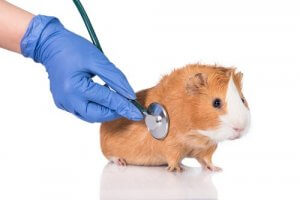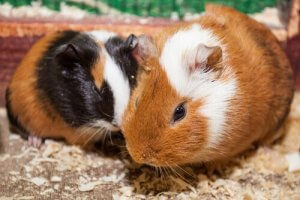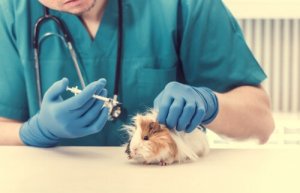Preventing Parasitic Infestations in Guinea Pigs


Written and verified by biochemistry Luz Eduviges Thomas-Romero
Clean, laid-back and easy to handle, these charming animals make great pets for children. However, it’s important to be on the look out for any sign of the parasitic infestations and infections in guinea pigs.
There are a number of illnesses which are very common in guinea pigs. As always, being properly informed is the key to combating any difficulties you may encounter.
In this article, we’ll take a look at the infestations and infections commonly seen in guinea pigs, so that you can be ready to spot any signs or symptoms in your pets.
What does a healthy guinea pig look like?
Your guinea pig should have a shiny coat, and clear, bright eyes. A guinea pig’s teeth are naturally yellow, and there should be no discharge from the nose or mouth.
A healthy guinea pig will have a good appetite, and the perianal area should be clean and dry.
A happy guinea pig will be active and playful. Apathy, lameness or tangled, ungroomed fur are signs that your guinea pig requires veterinary attention.
Guinea pig care: detecting parasitic infestations
Observation
It’s a good idea to get into the habit of checking on your guinea pig at least once a day. This will allow you to detect any issues early on, and ensure they get adequate treatment. Any weight-loss or loss of appetite could be a sign that your guinea pig is bored, unhappy or (worst case scenario) ill.
Finally, it’s important to keep an eye out for any dirt around the perianal area, as this can be an indication of diarrhea or an infection. The appearance of any dirt in this area is a sure sign that your pet requires veterinary attention.
Quarantine
If you have recently acquired a new guinea pig, it’s a good idea to put them in quarantine for a few weeks in a separate cage. Putting your new pet in quarantine before allowing it to meet your other guinea pigs will give you time to observe it, check for any signs of external parasites, and treat them before they have a chance to spread.

Food and bedding
Guinea pigs can catch parasites from one another, as well as from their food and bedding. Get in the habit of freezing food or bedding before putting it in your pets’ cage. The extreme temperatures will kill any potential parasites that might be lurking in the packaging.
Common parasitic infestations in guinea pigs
It’s very likely that your guinea pig will contract external parasites, such as fleas, lice or ringworm, especially if there are other animals (cats, dogs etc.) in the house.
Common symptoms that your pet may have picked up one of these parasites are constant itching, severe dandruff, and patchy hair loss. In some cases, the discomfort caused by the parasites can cause them to run in tight circles.
If left untreated, the animal will become slowly weaker. Prolonged exposure to external parasites may even lead to self-mutilation, or infections which enter the body through scratches on the skin. Without adequate treatment, the infestation will spread until it affects the entire body, and the animal may die.
Mites
Generally speaking, mites are one of the most serious parasitic infestations your guinea pigs can catch. Mites cause mange, an infectious skin disease that causes severe pruritis and alopecia. These parasites burrow into the skin, forming scabs, especially around the ears.
If hair-loss is also accompanied by patches of red or painful skin, it may be a sign that your guinea pig has mites.
In guinea pigs, most cases of mange are caused by Trixacarus caviae mites. They are so small that they can only be seen in skin scrapings under a microscope.

Mites can act as vectors for pathogenic microorganisms, especially when present in large groups.
Parasitic infestations: lice
Lice are small, flat, white insects that live in the fur of guinea pigs and other animals. Lice and their eggs can be seen with the naked eye, living in the bald spots behind guinea pigs’ ears. The species most commonly found on guinea pigs is Gliricola porcelli.
Adult lice and their eggs stick to the base of the hair. Their presence can go unnoticed for long periods of time, as they are generally only found in small numbers.
Severe lice infestations are rare, but when they do occur, they can cause severe pruritis, alopecia and skin lesions, especially behind the ears.
Mycosis or fungal infections
Mycosis is a fungal infection which affects the skin and nails. It’s spread by contact with an infected animal, or a contaminated cage.
The main cause of mycosis in guinea pigs is Trichophyton mentagrophytes. The infection causes hair loss and grayish scaling of the skin.
Treating parasitic infestations and infections in guinea pigs
If you think your guinea pig may be suffering from a parasitic infestation or fungal infection, it’s important to disinfect their cage, toys and any other equipment. Speak to your vet about the most appropriate course of treatment. It may take a few weeks for the treatment to eliminate the problem completely.

Your vet will be able to determine whether your guinea pig has mites, lice or another type of parasite. It’s important to thoroughly disinfect your guinea pig’s cage as soon as possible. First, take out all the bedding and throw it away. Spray the cage with a 10% chlorine solution diluted with water. Continue cleaning the cage like this once a week.
Clean, laid-back and easy to handle, these charming animals make great pets for children. However, it’s important to be on the look out for any sign of the parasitic infestations and infections in guinea pigs.
There are a number of illnesses which are very common in guinea pigs. As always, being properly informed is the key to combating any difficulties you may encounter.
In this article, we’ll take a look at the infestations and infections commonly seen in guinea pigs, so that you can be ready to spot any signs or symptoms in your pets.
What does a healthy guinea pig look like?
Your guinea pig should have a shiny coat, and clear, bright eyes. A guinea pig’s teeth are naturally yellow, and there should be no discharge from the nose or mouth.
A healthy guinea pig will have a good appetite, and the perianal area should be clean and dry.
A happy guinea pig will be active and playful. Apathy, lameness or tangled, ungroomed fur are signs that your guinea pig requires veterinary attention.
Guinea pig care: detecting parasitic infestations
Observation
It’s a good idea to get into the habit of checking on your guinea pig at least once a day. This will allow you to detect any issues early on, and ensure they get adequate treatment. Any weight-loss or loss of appetite could be a sign that your guinea pig is bored, unhappy or (worst case scenario) ill.
Finally, it’s important to keep an eye out for any dirt around the perianal area, as this can be an indication of diarrhea or an infection. The appearance of any dirt in this area is a sure sign that your pet requires veterinary attention.
Quarantine
If you have recently acquired a new guinea pig, it’s a good idea to put them in quarantine for a few weeks in a separate cage. Putting your new pet in quarantine before allowing it to meet your other guinea pigs will give you time to observe it, check for any signs of external parasites, and treat them before they have a chance to spread.

Food and bedding
Guinea pigs can catch parasites from one another, as well as from their food and bedding. Get in the habit of freezing food or bedding before putting it in your pets’ cage. The extreme temperatures will kill any potential parasites that might be lurking in the packaging.
Common parasitic infestations in guinea pigs
It’s very likely that your guinea pig will contract external parasites, such as fleas, lice or ringworm, especially if there are other animals (cats, dogs etc.) in the house.
Common symptoms that your pet may have picked up one of these parasites are constant itching, severe dandruff, and patchy hair loss. In some cases, the discomfort caused by the parasites can cause them to run in tight circles.
If left untreated, the animal will become slowly weaker. Prolonged exposure to external parasites may even lead to self-mutilation, or infections which enter the body through scratches on the skin. Without adequate treatment, the infestation will spread until it affects the entire body, and the animal may die.
Mites
Generally speaking, mites are one of the most serious parasitic infestations your guinea pigs can catch. Mites cause mange, an infectious skin disease that causes severe pruritis and alopecia. These parasites burrow into the skin, forming scabs, especially around the ears.
If hair-loss is also accompanied by patches of red or painful skin, it may be a sign that your guinea pig has mites.
In guinea pigs, most cases of mange are caused by Trixacarus caviae mites. They are so small that they can only be seen in skin scrapings under a microscope.

Mites can act as vectors for pathogenic microorganisms, especially when present in large groups.
Parasitic infestations: lice
Lice are small, flat, white insects that live in the fur of guinea pigs and other animals. Lice and their eggs can be seen with the naked eye, living in the bald spots behind guinea pigs’ ears. The species most commonly found on guinea pigs is Gliricola porcelli.
Adult lice and their eggs stick to the base of the hair. Their presence can go unnoticed for long periods of time, as they are generally only found in small numbers.
Severe lice infestations are rare, but when they do occur, they can cause severe pruritis, alopecia and skin lesions, especially behind the ears.
Mycosis or fungal infections
Mycosis is a fungal infection which affects the skin and nails. It’s spread by contact with an infected animal, or a contaminated cage.
The main cause of mycosis in guinea pigs is Trichophyton mentagrophytes. The infection causes hair loss and grayish scaling of the skin.
Treating parasitic infestations and infections in guinea pigs
If you think your guinea pig may be suffering from a parasitic infestation or fungal infection, it’s important to disinfect their cage, toys and any other equipment. Speak to your vet about the most appropriate course of treatment. It may take a few weeks for the treatment to eliminate the problem completely.

Your vet will be able to determine whether your guinea pig has mites, lice or another type of parasite. It’s important to thoroughly disinfect your guinea pig’s cage as soon as possible. First, take out all the bedding and throw it away. Spray the cage with a 10% chlorine solution diluted with water. Continue cleaning the cage like this once a week.
All cited sources were thoroughly reviewed by our team to ensure their quality, reliability, currency, and validity. The bibliography of this article was considered reliable and of academic or scientific accuracy.
- Gorman G. Texia; Zúñiga C. Rosario; Romero M. Sergio. (1986). Hallazgos de ectoparásitos en cobayos (Cavia Porcellus). Avances en Medicina Veterinaria, 1:1
- Huamán Alcantará, M., Killerby Campos, M., & Chauca Francia, L. (2019). Manual de Bioseguridad y Sanidad en Cuyes.
- Fuentealba, C., & Hanna, P. (1996). Mange induced by Trixacarus caviae in a guinea pig. The Canadian Veterinary Journal, 37(12), 749.
- Viguié, C. Paugam, A (2009). Dermatofitos transmitidos por animales. Acta Bioquim Clin Latinoam, 43:263-270.
This text is provided for informational purposes only and does not replace consultation with a professional. If in doubt, consult your specialist.








